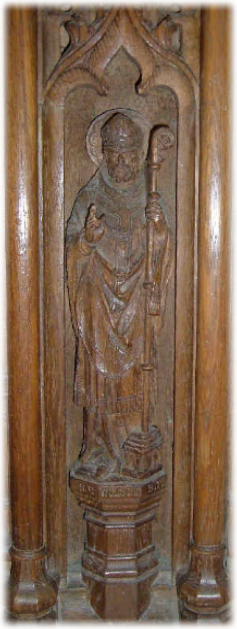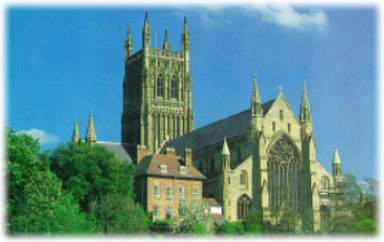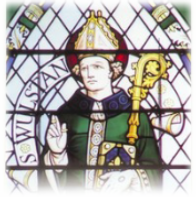FRIENDS OF CLAINES CHuRCH
Happy Birthday to St Wulfstan!
1008-
Bishop of Worcester
Last of the Anglo Saxon Bishops
Builder of Claines Church
This year, on January 19th, saw the celebration of 1000 years since St Wulfstan was born. We remember his special link with Claines Church.
St John Baptist is the Saint most readily associated with Claines Church, the Church carrying his name, as our patron saint.
However Saint Wulfstan is our “second saint”. Close observers will notice that we have two carved oak statues on our main Altar reredos. One of those is John the Baptist, and the other is St Wulfstan, complete with Bishops mitre, and his staff resting on a church.
Wulfstan was the builder of the first church at Claines. He replaced the original wooden Saxon chapelry at Claines. He built churches in all his manors and the church at Claines was originally called the church of Northwick, after Northwick Manor. The date of his church at Claines was uncertain, but it must have been built between 1075 and 1095, the year of his death. It became known as Claines Church by 1097. It was originally a chapelry annexed to St Helens.
Wulfstan devoted a proportion of the tithes from Claines to the Commandery (Hospital of St Wulstan) which he founded. Because of this the brethren of St Wulstan at the Commandery continued to be responsible for the repairs to the south side of the chancel at Claines until the end of the 13th century.
Wulfstan’s life was an interesting one.
He was known as the last of the Anglo Saxon Saints and as a Church Builder
He was born about 1008 at Long Itchington in Warwickshire. He studied at monasteries in Evesham and Peterborough, before becoming a clerk at Worcester. During this time his superiors, noting his reputation for dedication and chastity, urged him to join the priesthood. Wulfstan was ordained shortly after, in 1038, and soon joined the monastery of Benedictines at Worcester.
Wulfstan served as treasurer and then prior of Worcester. Considering how well financially and spiritually the monastery did under his care, Wulfstan was consecrated Bishop of Worcester on September 8, 1062. He was a social reformer and struggled to bridge the gap between the old and new regimes, and to alleviate the suffering of the poor. After the Norman conquest of England, Wulfstan was the only bishop allowed to keep his old post by William I of England, noting that pastoral care of his diocese was Wulfstan's principal interest. After the Norman conquest attempts were made to depose him. He stated that he knew himself to be unworthy of the office of bishop and had only accepted it at the command of his master, King Edward, and then going to King Edwards tomb, he laid his staff upon it, and resigned it to him. The story is that the staff remained fixed and immovable, and that neither King nor archbishop could shift it, while Wulfstan could take it up at will, and that owing to this miracle the sentence of deposition was rescinded.

St Wulstan on the Altar reredos at Claines Church
He is responsible for the founding of Great Malvern Priory, and undertook much large scale rebuilding work including Worcester Cathedral, Hereford Cathedral, Tewkesbury Abbey, and many other churches in the Worcester, Hereford and Gloucester areas, including Claines.
When his work at the Cathedral was finished he exclaimed with tears
“The saintly men of old cared more to bring themselves and their flocks to God than to build fine churches. All we do is to raise piles of stones; for souls we do not care.”

Worcester Cathedral today
Wulfstan used his influence to put down the slave trade with Ireland, which involved the kidnapping of English men and women and selling them as slaves. He went to the slave trading headquarters at Bristol and preached to the traders, Sunday after Sunday until the trade came to an end.
Wulfstan died on January 19th 1095
He was canonized on May 14th, 1203 by Pope Innocent III.
A special celebration of the 1000th year of his birth was held at Worcester Cathedral on 18th January, the eve of his feast day. Further celebrations will follow.
See the new Cathedral website for further details.
References:
Everyman’s Book of Saints. Mowbray 1914.
St Wulfstan, Wikipedia
Claines and Its History; Eric Baker



